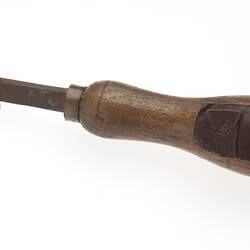Summary
Similar to many of Stanio Fancoff's other shoemaking tools, this instrument appears to have the customary leather strap for hanging during storage, the decorative incised lined handle and signs of usage. Although it is difficult to determine this particular tool's use, Stanio Fancoff was a dedicated shoemaker and as such his shoemaking tools were an essential part of his life and livelihood.
Stanio Ivanoff Fancoff was born in 1908 in Bojentsi, a small village in Bulgaria. At age 11, Stanio left home to learn the shoemaking trade. In 1929, he immigrated to Melbourne, settled in Fitzroy and began to work for the V.G. Zemancheff & Sons basket shoe factory in South Melbourne. In1936, he married Dorotea Georgi Touzou who had recently arrived in Australia. Around this time, Stanio set up his own shoemaking business from home, with Georgi, her cousin and sister weaving the shoes which he then assembled. Select shoe samples were then taken to Sydney and Tasmania for sale. In 1942, Georgi and Stanio moved to Broken Hill for Georgi's health; there daughter Nancy was born and Stanio set up a shoe shop/factory. In 1945, Georgi died and by 1950 Stanio and Nancy had moved to Adelaide where he again opened a shoemaking business and shop. He passed away in 1978, having been in the shoemaking business for 59 years. This collection documents his migration and working life experiences.
Physical Description
Similar to many shoemaker tools, this unknown tool combines a medium coloured wooden handle with a attached metal instrument. The instrument with its metal necktie exhibits signs of ageing. At the instrument's end two screws hold attachments in place. The first attachment is unknown, but what remains references a possible wheel. The second retains an adjustable arm, allowing the tool a permanent measuring device. Underneath these two devices on the instrument's face is the instrument's makers trademark "'A (? possibly the shoe image trade mark) / GEORGE / BARNSLEY/ SHEFFIELD". The medium brown hour shaped wooden handle has singular horizontal lines incised within the upper and lower handle portions. Furthermore, it has a medium tanned leather strap with a button hole plus an additional leather piece simultaneously singularly tacked the handle's lower portion.
Significance
This collection is significant in documenting a small migrant business as well as the fashion of a particular period. It is well provenanced and charts the application of trade skills in a new country. It also illustrates the stages of hand shoe manufacture from the 1930s, demonstrating the enduring nature of the tools and patterns that were used.
More Information
-
Collecting Areas
-
Acquisition Information
Donation from Nancy Vasileff, 21 Mar 2007
-
Past Owner or User
-
Inscriptions
Flat Metal Face - 'A / GEORGE / BARNSLEY/ SHEFFIELD"
-
Classification
-
Category
-
Discipline
-
Type of item
-
Overall Dimensions
145 mm (Length), 30 mm (Width)
-
References
R.A. Salaman, 'Dictionary of Leather-working Tools c.1700-1950 and Tools of Allied Trades,' London: George Allen and Unwin (Publishers) Ltd, 1986 [Section 2: Boot and Shoe Maker pp18-185]. John Peacock. 'Shoes, The Complete Sourcebook,' London:Thames & Hudson Ltd, 2005. NAA holds file (online) on Vasil George Zemancheff, Fancoff's employer
-
Keywords
Boot & Shoemaking, Bulgarian Communities, Bulgarian Immigration, Immigration, Small Businesses, Tools






